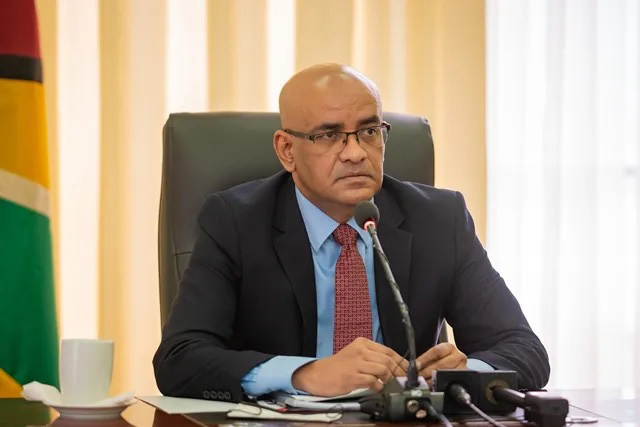-Jagdeo says it could be US$11 monthly
As they head to arbitration with government adamant in giving the Wales Gas-to-Energy (GtE) project contractor, Lindsayca/CH4, a three-month extension instead of the US$50 million it seeks and a longer delay, the company was yesterday put on notice that it will be charged stiff liquidated damages if it loses.
“There is a delay, now because the site was handed over late… we said what we believe is justified is a three-month extension to the contract. We offered that. The company doesn’t want that. They want more money… they want a bit more money and they want a longer extension. They’ve asked for a longer extension.” Vice President Bharrat Jagdeo yesterday told a press conference held at Freedom House, Georgetown.
“We have an arbitration now taking place and if we win the arbitration, they would have only by April to deliver this project. They have given a schedule which shows [project delivery] later in the year – that is what Winston Brassington spoke of – but I did not want the public to think that we agreed to their schedule. We have only given an approval for three-month extension. So, if we win the arbitration and we stick with that schedule then there would be liquidated damages,” he added.
Jagdeo calculated the liquidated damages at US$11 million-plus monthly, explaining that from whenever the ruling date for an extension, if any, to the company, government will begin instituting the daily penalty.

It is the first time government has publicly admitted that the company has said that it wanted both a longer project delivery time and the sums it seeks through arbitration.
Details of the arbitration did not come initially from government, but followed a Reuters report which stated that the company was seeking US$90 million. It was only after that did government release word that there was a dispute which went to arbitration and clarified that the sum sought by Lindsayca/ CH4was US$50 million.
Project Lead, Brassington, had on Thursday made a presentation to an American Chamber of Commerce Guyana event at the Marriott Hotel and disclosed that civil works had seen the project delayed but both parties had agreed the project will be completed by the second half of next year.
This newspaper reported from that presentation which was shared by the Department of Public Information.
Brassington noted that the project delays are due mainly to soil stabilisation works which took longer than anticipated. “The soil stabilization has taken a lot longer. It has been a very technical process. So the civil schedule is what is driving, a very critical part, the other items are a little behind but not as much as the civil schedule,” Brassington said.
 Some 1.65 million cubic metres (m3) of sand had to be brought in for soil stabilisation. In addition to the sand, he said that 160,000m3 of loam and 25,000m3 of crusher run had to be used for the stabilisation exercise, Brassington had disclosed.
Some 1.65 million cubic metres (m3) of sand had to be brought in for soil stabilisation. In addition to the sand, he said that 160,000m3 of loam and 25,000m3 of crusher run had to be used for the stabilisation exercise, Brassington had disclosed.
“But all of this being said, the parties have agreed that sometime in the second half of next year, I don’t want to be precise right now because there are a number of moving parts, but we believe that this will be achieved,” he added.
‘Chatham House Rules’
In a release via DPI yesterday, Brassington said he wanted to clarify recent press reports but did not name the news entity saying that the event, which discussed the spending of billions of taxpayers’ dollars, was held under Chatham House rules.
The Chatham House Rule is an agreement between meeting participants that allows the use of information from a discussion, but prohibits any mention of who the speaker was, or to what organisation they are attached.
“Head of GtE Task Force, Winston Brassington, has noted recent reports in the newspapers, emanating from a closed-door presentation to an AMCHAM forum held last Thursday September 19. It is important to note that the AMCHAM forum was held under Chatam [sic] House rules, and no media were invited or present. Despite this, certain information has flowed into the media,” the release said.
In an invited comment, Stabroek News Editor-in-Chief Anand Persaud said that Brassington seemed unaware that the entire session was recorded by DPI and released by it to the public.
Brassington’s press release said that “The presentation made clear that the Integrated Power Plant/NGL plant project is late with the current projected completion being H2-2025. What was not discussed in the presentation is that certain disputes are before the DAAB (Dispute Avoidance/Adjudication Board) Tribunal”.
The release stated said that under the GOG- Lindsayca/CH4 December 2022 contract, “delivery of the “simple cycle/NGL facilities” was contractually scheduled for delivery on December 31, 2024. Due to a delay of three months, caused by Exxon sub-contractors, the GoG has accepted a schedule extension of 3 months in favor of the Contractor.”
Further, “the 3-month delay resulted from Exxon sub-contractor, GYSBI, being late in completion of site work for the 100-acre site by 3 months, and Exxon sub-contractor, GAICO, being late with respect to completion of the Material offloading Facility (MOF) by 3 months. Flowing from the above, it is to be made clear, that the GoG holds Lindsayca/CH4 contractually responsible to deliver the project in “simple cycle” by April 2025.”
The statement added that it is the government’s intent “to charge liquidated damages on any delay thereafter at a Liquidated Damages (LD) rate of $377,000/day per the contract. This amounts to US$11.3 per month.”
‘Proceeds from gas’
And as government prepares for a contractor to operate and maintain the project plant, even as questions remain about the repayment of over US$1 billion, Jagdeo said that as had been explained, ExxonMobil would be repaid US$55 million annually from the sale of the gas and the price of power.
“We have to pay back up to US$55 million per year and it comes out of the proceeds from the selling of the liquids and the price we pay for electricity,” he said.
When the project was launched in 2021, Jagdeo was bullish on the investment for it and assured that the approximate US$810-900 million project will produce power at around US 7 cents per KWH compared to US 14 cents that the Guyana Power and Light is producing at.
At a meeting that same year that government had held with editors, publishers, and reporters, from the country’s major media houses, Jagdeo had pointed out that he arranged it so that “a lot of misconceptions” could be cleared up.
Then, Brassington had also made a PowerPoint presentation which he said included data from the five pre-existing studies. His presentation is now on the Ministry of Natural Resources’ website.
At that meeting, Stabroek News had expressed concern at government’s decision to use pre-existing studies alone, to come to major decisions that would utilise billions of taxpayers’ dollars.
“I have never heard of a government anywhere, embarking on a project that might cost US$900 million based on pre-existing studies. Particularly studies done under the previous government (when the two governments) don’t see eye to eye on anything. I don’t know how one can argue that we can embark on a major project like this. This is not purpose built to what the PPP/C might have envisaged in its manifesto or even before it came to office. When you rely on those [studies], it would seem to be opportunistic and solely intended to provide a certain result without you having designed a purpose-built study that would (address) the PPP/C’s issues,” Stabroek News’ Editor-in-Chief Anand Persaud had stated.
“One of the major concerns is that you are embarking on a project but yet you have come to major decisions on a lot of things. Embarking in that way, raises serious questions on the due diligence that has been done, or if at all, and will be one of the lasting concerns that people have,” about the project, he emphasised.
Jagdeo responded by stating that exhaustive work was done as a pre-requisite for the project but that his government understands that detailed studies are imperative for a final decision on the project and that is why it would soon begin those.
He promised that as those studies were ongoing, the public would be updated on findings and that government would be transparent in the execution of the project.
This then leads to the question as to why the offshore pipeline aspect was not discussed. Two years later, at the 2023 Oil and Gas Conference, Brassington informed that $400 million had been set aside for land compensation and that ExxonMobil will be repaid US$55 million per annum for 20 years from cost oil, for its US$1.1 billion infrastructure input.
“The Government of Guyana’s payment to Exxon co-venturers for its US$1 billion investment in the pipeline will be US$55 million per annum over a 20-year period. This payment is fixed over the 20-year period and will have no adjustment. It is calculated to allow Exxon COVs (coventurers) to recover their investment of US$1 billion over the 20 years,” he had said.
On Sunday, former finance minister Winston Jordan stated that with no agreement between the government and ExxonMobil made public or shared with the Parliament on how the pipeline for the more than US$2 billion gas-to-energy (GtE) project is being funded, it seems the government has taken an illegal loan.
“We have no agreement in public of what is the arrangement with ExxonMobil for them fronting the pipeline. All we have is statements, from time to time, from [Project Lead Winston] Brassington and [Vice President Bharrat] Jagdeo. Not even calls by the Parliamentary Economic Committee have been answered. There is just nothing, nothing, nothing! How does one start a project and not formalise agreements?” he asked rhetorically in an interview with the Stabroek News.
Jagdeo yesterday retorted that Jordan needed to be questioned about decisions he made when he was Minister and that the repayment was the same as had been stated and from the sale of gas.
He did not say if government would share that agreement with this country’s Parliament.
However, he assured that the project was a feasible one and that persons would see connection to the grid “happen almost immediately”.
“Because if we’re getting all this power in the grid immediately, that means we can turn off a lot of the high-cost generating equipment that we have now and substitute these with the new power plant. So the benefit would be seen almost immediately,” he said explaining that the current gensets would be maintained and on standby in the event of an emergency.





